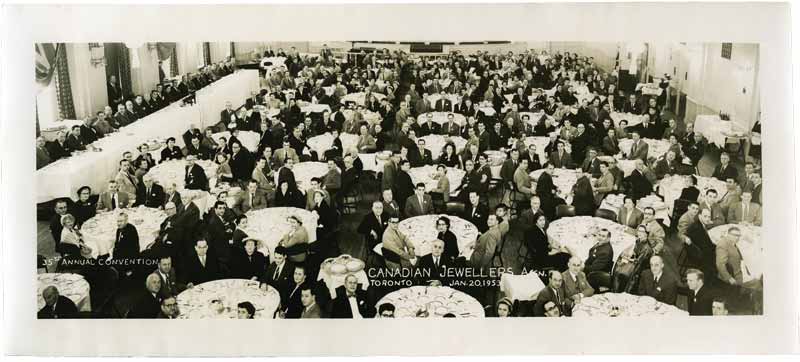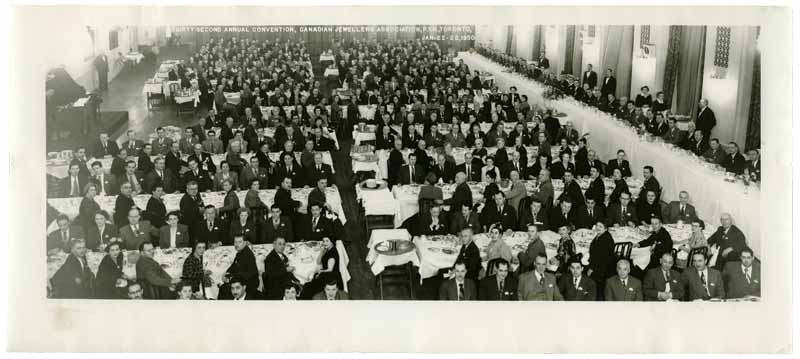By Brian Land

The Canadian Jewellers Association (CJA) was born on September 25, 1918, from the co-operative combination of retailers, manufacturers, and wholesalers. The original name of the group was the Canadian National Jewellers Association (CNJA), but it was changed to its current form in April of 1922. As the association turns 100, it is important to look back at the steps that brought it to the present day.
Watering the roots
CJA’s first Executive Committee meeting was held on February 19, 1919. Between the group’s formation and this first meeting, membership grew to 157. Small retailers with less than 10 employees could join the association for $2 per year, the equivalent of about $30 today. As you can imagine, membership was one of the prime directives for the new association, along with the requisite structural and functional organizational tasks.
Another significant concern was the prejudicial and punitive excise tax placed on luxury goods to support the war effort. CJA’s fight against this tax would continue unabated for 88 years, through Royal Commissions, briefs before Senate committees, and hundreds of meetings with MPs, ministers, and bureaucrats.
Membership was an easier challenge for the dynamic group that founded the association. By November 1919, the membership rolls had grown to 417, and then to 739 by the end of 1920. The technique CJA used was simple: repetition and personal contact. The young organization identified a mailing list of prospective members, who were sent multiple invitations to join. Coupled with cross-Canada visits from jewellery travellers, support from provincial and district associations, and national tours by the Executive Committee members themselves, this effort met with strong success.
CJA’s first convention and annual general meeting (AGM) was held in Montréal in 1920. Many resolutions were generated there, such as standardized repair price lists, the requirement suppliers not sell directly to consumers, and a national three-month guarantee on watches. However, the most interesting idea to come out of the convention was the Jewellery Publicity Campaign, which supported CJA’s founding principle of promoting the jewellery business across Canada. The association even developed a positioning line: “Gifts that last.”
Another significant accomplishment of the early days was the development of a country of origin mark for Canada. A maple leaf superimposed on the letter C, the design was presented to CJA by its first president, M.C. Ellis. This initiative reflected CJA’s deep concerns regarding the lack of standards relating to imported products. The association also greatly contributed to writing the Gold and Silver Marking Act of 1923, the forerunner to today’s Precious Metals Marking Act.
In the CJA secretary’s year-end report for 1928, this boast appears: “From practically every centre comes the report of a very satisfactory business last year, and the outlook for 1929 should certainly not be less favourable.”
However, everyone knows what happened after the stock market crash of October 1929—the Great Depression. By 1934, CJA membership had fallen to 526, and business was reported to be 63 per cent of the 1930 volume. The Depression lasted until 1939.
Fortunately, CJA was able to help its members recover by assisting with remerchandising stores, providing any point-of-sale material, and addressing unethical practices. However, global political problems took over with the advent of the Second World War, which created a new set of issues for the association. The jewellery business suffered under new funding schemes, including a 25 per cent retail tax and restrictions imposed on the industry through the Wartime Prices and Trade Board.
However, the war also sparked a number of tremendous contributions and sacrifices by members of the jewellery industry. For example, in response to the call from the federal government to assist in the war effort, CJA undertook what was called the ‘Hurricane Campaign,’ setting a goal to solicit $50,000 from members to supply two Hurricane Fighter planes to the Royal Canadian Air Force (RCAF). Believe it or not, the response was such that within a few months, the group had collected $110,000—the modern-day equivalent of $1.7 million. This was more than enough to build four Fighters.
The industry also sent more than 1300 of its members into the armed forces, and many more into the service of the government through the war factories. In 1943, in recognition of all the soldiers had faced and done, CJA began to plan for the returning veterans, establishing a Post-war Planning Committee to address job creation after military service. In concert with this, the association began an extensive education program. As a result, in 1944, the Canadian Jewellers Institute (CJI) was chartered.
After the war, business and the association steadily grew. CJA opened its first permanent office in 1946, and manufacturers and wholesalers prospered as restrictions were lifted and retailers replenished their inventories. By 1952, membership had grown to 1896, and CJA reported more than 112,000 mailings from the office, 30,000 of which related to CJI. In 1957, the group also initiated a National Jewellery Week, running November 18 to 23. This resulted in more than 100,000 lines being purchased in newspapers across Canada and an additional 50,000 lines in free editorials and pictures.
Throughout the history of CJA, there are examples of the organization taking the lead to promote the jewellery business for its members. These include the 1964 ‘Holiday in Europe’ consumer contest (which saw 660 member stores participate across 159 Canadian municipalities) and the Marketing Excellence Program of the 1980s (which co-ordinated point-of-purchase kits and public relations media press kits to be sent to 150 radio stations and 100 newspapers quarterly).
Focusing on the future
The period from 1980 to 2017 has been, as Dickens said, the best of times and the worst of times. This timespan includes highlights such as the appointment of CJA’s first female president, Carla Hiscock, in 1987, and the amazing turnaround and energizing of the association by general manager John Theo, who initiated such achievements as the launch of Jewellers Vigilance Canada (JVC). It also includes the final repeal of the excise tax, engineered by Pierre Akkelian and Jonathan Birks. However, problems have also arisen, such as the way jewellery products have been turned into commodities and the way the appetite for online shopping has grown, limiting the trade’s ability to relate to the new jewellery consumer.
Over the years, CJA has faced numerous, often-recurring problems, such as false and misleading advertising (which led to the establishment of Jewellers Vigilance Canada [JVC] in 1987), declining membership and revenues, and the biggest evil of all: unfair tax burdens like the excise tax. The good news is the association has been blessed with dedicated members who have persevered and overcome all obstacles.
As CJA enters a century of new challenges and victories, perhaps it should change its current slogan, “A sign of trust,” to the U.S. Naval Construction Battalions motto: “The difficult we do immediately. The impossible takes a little longer!”






